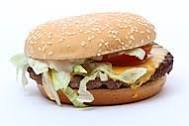(....meaning of JUNK FOOD is food that is high in calories but low in nutritional content. -- blogger....
** Soda
** Fried Chicken
(Made from conventional chicken laden with hormones and antibiotics, covered with gluten-containing breading and chemicals like MSG and salt, and fried in cheap, rancid oils, fried chicken is high in calories, fat, and other chemicals that can make you sick. Skip it altogether. Please, please, just never eat fried food)
*** Egg and sausage sandwich
Hormones, salt, antibiotics, and dairy make that breakfast sandwich a non-healthful choice.
** Bacon cheeseburger
** French fries
Talk about an unhealthy snack! Fries are simply salty, unhealthy fat bombs fried in the worst possible rancid oil.
Milkshake
Milkshakes are one of the most popular junk food examples, and for good reason! Loaded with saturated fat, added sugar, conventional dairy, and often chemicals for flavoring, milkshakes can leave you feeling sluggish and sick. Skip them. (based on net research)
*****
Like cigarettes, junk food should come with a warning: ‘Can kill’
Only regulation will stop fast food firms churning out products we are evolutionarily hardwired to find it difficult to resist, says
Martha Gill
"The 1970s was a confusing decade in which to be a smoker. People knew, of course, that smoking was bad for them: the evidence linking it to lung cancer had been incontrovertible since 1956. But despite government education programmes, hiked taxes and restrictions in selling to children, these warnings hadn’t fully permeated the atmosphere.
How could they? Daily life bathed the brain in the idea that smoking was fine. Cigarettes were advertised in magazines, on billboards and at sporting events; they dangled from the mouths of the suave or rebellious in film and on TV; and a nicotine fug enveloped offices, bars and public transport. Could something that everyone was doing, and which suffused the culture, really be that shockingly dangerous?" -- she writes.
It was a confusing time, also, to be a tobacco company. You could no longer claim that smoking was supported by doctors, as you did in the 50s – but you were not yet forced to admit on every packet that your product actually killed people. It was only in the 80s and 90s that, festooned with obligatory warnings, cigarette ads started to flirt openly with death: one advert for Silk Cut referenced the shower scene in Hitchcock’s Psycho, another for Benson & Hedges featured a dead fish on a coffin-like piano. (If you’re going to die, die with us.)
But in the 70s these companies were still making the uneasy transition between denial and nihilistic acceptance. The idea that you could make cigarettes healthier, that you could acknowledge the warnings but claim they did not apply to your own product, became a central defence and marketing ploy. New “filter” cigarettes (themselves sometimes tainted with dangerous chemicals) flooded the market, falsely claiming to protect against the worst harms of smoking. Thousands switched to “low-tar” cigarettes in an effort to make a healthy choice.
“Considering all I’d heard, I decided to either quit or smoke True. I smoke True” ran one advert in 1976, featuring a sporty-looking girl at a tennis net – “The low-tar, low-nicotine cigarette”.
"I think, in 2024, with what used to be called junk food, and which is now beginning to be called ultra-processed food. UPF is food that has at some stage been ground into unrecognisable pulp and bathed in additives, a definition that is gaining acceptance among experts. But it is nothing too new. We are now, and have been for years, talking about the kind of food that encourages us to eat vast quantities of salt, sugar and fat in one barely chewed gulp. It is hamburgers, crisps, chocolate bars, ice-cream, fizzy drinks and pappy processed cereal," runs the article.
"As with cigarettes in the 70s, much of the evidence is in. Junk food is linked to cancer. Two landmark studies last year showed UPFs caused heart disease and strokes. It is also beyond question that these kinds of foods cause obesity, a condition linked to 30,000 deaths a year in England alone.
One in five children are obese by the final year of primary school and levels of obesity are spiralling upwards. Unhealthy diets are, worldwide, now killing more people than tobacco," Martha Gill notes.
But these warnings have yet to filter through to our daily environment, in which junk food is beamed at us from bus stops and TV ad breaks – framed as an indulgence, a guilty pleasure, but not a scourge.
"Our brains, evolved for scarcity, navigate a world of cheap, easy, delicious dopamine hits on high streets and supermarket aisles. Fast food companies follow teens online and use cartoons to sell unhealthy cereals. Last week, an 18-year-old told the Times that, when she got her GCSE results, she was congratulated by the pizza chain Domino’s before her mother.
Last week, the youth activist movement Bite Back published its study Fuel Us, Don’t Fool Us, developed with researchers at Oxford University, and reported that Ferrero made 100% of its UK sales in 2022 from foods high in saturated fat, salt and sugar (HFSS).
In response, a company spokesperson claimed it was “supporting consumers” by “offering our products in small, individually wrapped portions” along with “education on how to enjoy our products as part of a balanced lifestyle”. Are you really supposed to stop after a single (wrapped) Ferrero Rocher?"
'Junk food' is food that contains high levels of fats, salt or sugar, and lacks nutrients such as fibre, vitamins and minerals.
ends







No comments:
Post a Comment